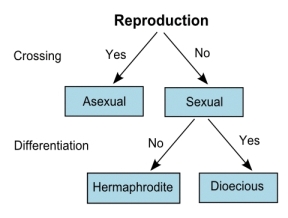|
The Evolutionary Theory of
Sex:
Three Main Types of Reproduction

Asexual — a form of
reproduction, such as budding or simple fission that does
not involve the fusion of gametes. With this type one kind
of organisms, produce the same progeny.
Asexual type is common amongst
bacteria, algae, amoebas and infusorians.
Hermaphroditism — the
coexistence of both male and female sex organs in the same
organism.
Worms, many mollusks, some fishes,
vast majority of plants.
Dioecious (bisexual) — two
kinds of organisms, male and female.
Female
— an individual that bears young or produces large usually
immobile gametes (as eggs).
— a pistillate plant.
Carries Venus sign ♀
Male —
an individual that produces small usually mobile gametes (as
spermatozoids) which fertilize the eggs.
— a staminate plant.
Carries Mars sign ♂
Primitive organisms are asexual.
Hermaphrodite types can be considered as an intermediate or
transitional stage to dioecy
All advanced species (mammals, birds, insects, dioecious
plants, and others) are bisexual.
Three Main
Types of Reproduction
First important event - appearance of crossing
(fertilization) processes - lead to creation of sexual
forms. Crossing made possible to combine
the genetical information of parents. With crossing all
types of reproduction, existing in animals and plants was
divided by two main types—asexual (no crossing) and sexual
(crossing is present).
Second important event was appearance
of sexual differentiation—division into two sexes
with prohibition of crossing between the organisms of the
same sex. The sexual process and sexual
differentiation are different and, in
essence, opposite phenomena. The first creates
(increases) diversity of genotypes, and this is its
evolutionary role; the second, in fact, decreases it in
half, and nobody can explain its evolutionary role.
Depending on the presence or absence
of crossing and differentiation, the existing
ways of reproduction can be divided into three main forms:
asexual, hermaphrodite, and dioecious (Figure).

Advantages and Disadvantages of
Different Reproduction Types:
Asexual types:
Advantages: There is no need to find a partner. Simplicity.
Disadvantage: Slow changes only by accidental mutations.
Advantages of fertilization:
Genetical recombination
Avoid inbreeding
Amount of combinations for N
organisms:
Asexual
N
Hermaphrodite N * (N - 1) / 2 ~=
NČ / 2
Bisexual (N / 2) * (N /
2) = NČ / 4
What are the Advantages in Having
Two Separate Sexes?
There is a clear advantage of
sexual forms compare to asexual, but nothing so
far can justify transition to dioecy.
Bisexual forms have 2 times less
combination potential compare to hermaphrodites, so
advantages of differentiation are still unclear.
Back to The Evolutionary Theory of
Sex
|